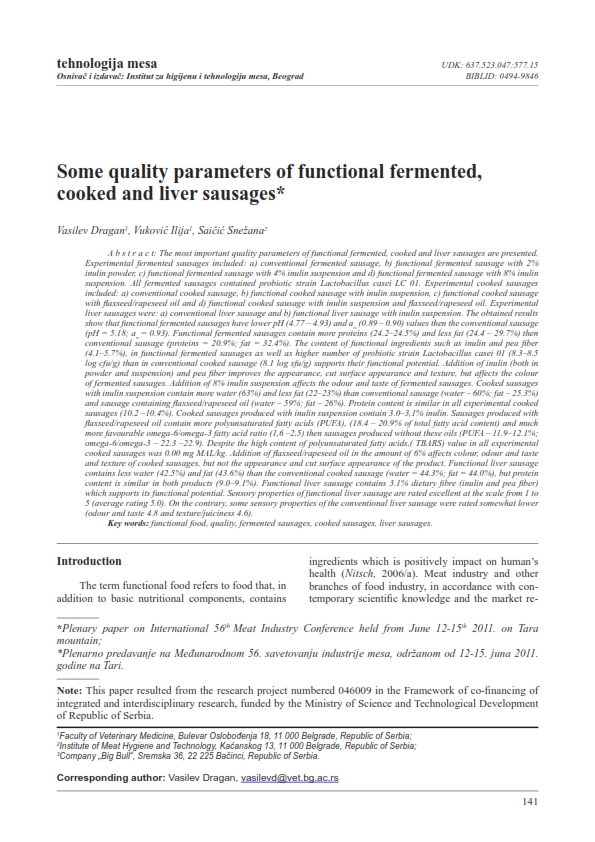Some quality parameters of functional fermented, cooked and liver sausages
Abstract
The most important quality parameters of functional fermented, cooked and liver sausages are presented. Experimental fermented sausages included: a) conventional fermented sausage, b) functional fermented sausage with 2% inulin powder, c) functional fermented sausage with 4% inulin suspension and d) functional fermented sausage with 8% inulin suspension. All fermented sausages contained probiotic strain Lactobacillus casei LC 01. Experimental cooked sausages included: a) conventional cooked sausage, b) functional cooked sausage with inulin suspension, c) functional cooked sausage
with flaxseed/rapeseed oil and d) functional cooked sausage with inulin suspension and flaxseed/rapeseed oil. Experimental liver sausages were: a) conventional liver sausage and b) functional liver sausage with inulin suspension. The obtained results show that functional fermented sausages have lower pH (4.77 – 4.93) and aw (0.89 – 0.90) values then the conventional sausage (pH = 5.18; aw = 0.93). Functional fermented sausages contain more proteins (24.2–24.5%) and less fat (24.4 – 29.7%) then conventional sausage (proteins = 20.9%; fat = 32.4%). The content of functional ingredients such as inulin and pea fiber
(4.1–5.7%), in functional fermented sausages as well as higher number of probiotic strain Lactobacillus casei 01 (8.3–8.5 log cfu/g) than in conventional cooked sausage (8.1 log sfu/g) supports their functional potential. Addition of inulin (both in powder and suspension) and pea fiber improves the appearance, cut surface appearance and texture, but affects the colour of fermented sausages. Addition of 8% inulin suspension affects the odour and taste of fermented sausages. Cooked sausages with inulin suspension contain more water (63%) and less fat (22–23%) than conventional sausage (water – 60%; fat – 25.3%)
and sausage containing flaxseed/rapeseed oil (water – 59%; fat – 26%). Protein content is similar in all experimental cooked sausages (10.2 –10.4%). Cooked sausages produced with inulin suspension contain 3.0–3,1% inulin. Sausages produced with flaxseed/rapeseed oil contain more polyunsaturated fatty acids (PUFA), (18.4 – 20.9% of total fatty acid content) and much more favourable omega-6/omega-3 fatty acid ratio (1,6 –2,5) then sausages produced without these oils (PUFA – 11.9–12.1%; omega-6/omega-3 – 22.3 –22.9). Despite the high content of polyunsaturated fatty acids,( TBARS) value in all experimental
cooked sausages was 0.00 mg MAL/kg. Addition of flaxseed/rapeseed oil in the amount of 6% affects colour, odour and taste and texture of cooked sausages, but not the appearance and cut surface appearance of the product. Functional liver sausage contains less water (42.5%) and fat (43.6%) than the conventional cooked sausage (water = 44.3%; fat = 44.0%), but protein content is similar in both products (9.0–9.1%). Functional liver sausage contains 3.1% dietary fibre (inulin and pea fiber) which supports its functional potential. Sensory properties of functional liver sausage are rated excellent at the scale from 1 to 5 (average rating 5.0). On the contrary, some sensory properties of the conventional liver sausage were rated somewhat lower (odour and taste 4.8 and texture/juiciness 4.6).





